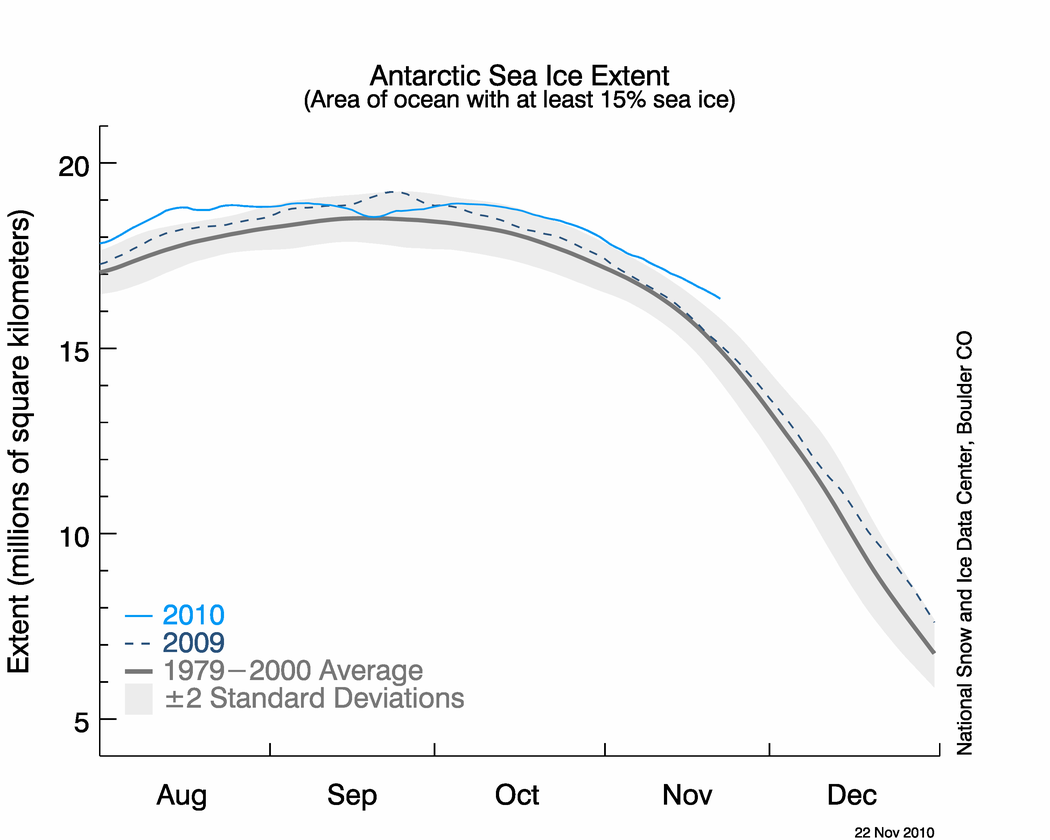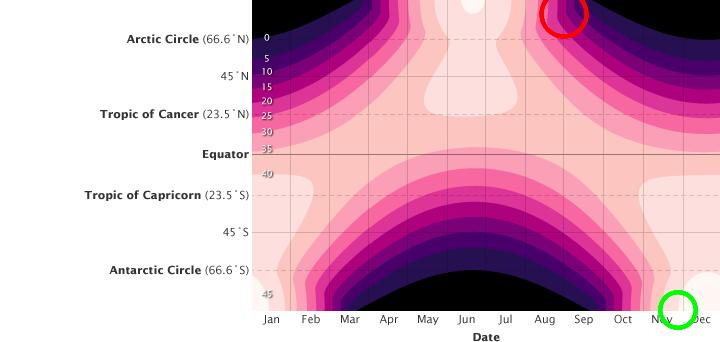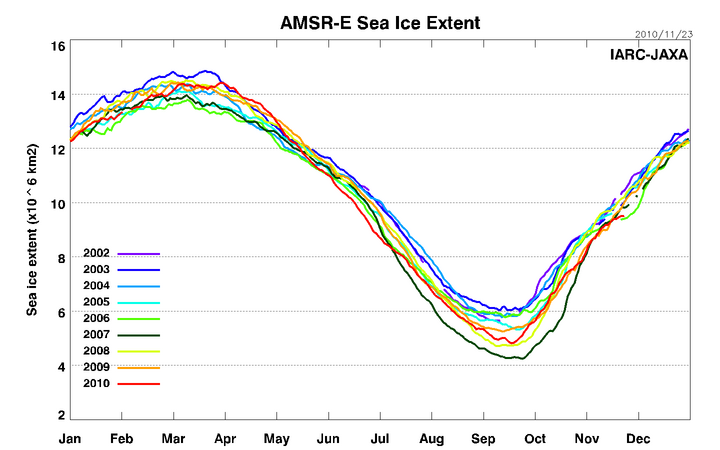[youtube=http://www.youtube.com/watch?v=-wbzK4v7GsM]
Peter Sinclair reels off one piece of misinformation after another in his monotone voice. Here are a couple of them.
Around time 4:40 he compares ice loss in the Arctic vs. ice gain in the Antarctic using percentages rather than absolute numbers. Perhaps he doesn’t realize that there is a lot more sea ice in the Antarctic, so the percentages are of course lower? When we measure the absolute extent of Arctic loss (red below) vs Antarctic gain (blue below) we see that they are currently about equal.
 ‘
‘
If a 100 pound person loses 10% of their weight, and a 500 pound person gains 2% of their weight, what is the net change in total weight? Zero. That is why people don’t report weight in percentages.
Then around 5:15 he goes completely clueless when he claims that northern sea ice anomalies occur in summer when the sun is high in the sky, but southern sea ice anomalies occur in winter when the sun is low. Perhaps he doesn’t understand that seasons are reversed in the southern hemisphere?
The Antarctic is three standard deviations above normal, and solar energy is at its peak – as seen in the green circle below. By contrast, the Arctic peak ice loss occurs in September when there is very little solar energy being received (red circle below.)
http://earthobservatory.nasa.gov/Features/EnergyBalance/page3.php
2010 ice took its dip starting in early September, when the Sun was very low in the sky (red circle above) so it actually acts as a negative feedback. The open water allows LW radiation to escape from the ocean, with minimal SW warming the water that time of year.
Another very important consideration is that excess Antarctic ice occurs at low latitudes where the sun shines directly on the ice, while Arctic deficiencies occur at high latitudes where the sun is oblique. The Antarctic positive anomalies have much more effect on the Earth’s SW radiative balance than do the Arctic negative anomalies.
At another point he claims that the Arctic is in a “death spiral” in spite of the fact that the minimum has increased by 20% over the last three years.
The amount of multi-year ice increased from 2008 to 2009, 2009 to 2010, and will undoubtedly increase again from 2010 to 2011. Some death spiral.





Of all the stupid statements in the video I think Adm. Titley’s was the worst. How can he know that the ice amount is at the lowest in thousands of years. Dumb.
Viking, Saxon and Roman submarine records.
Satellite photos from the Greeks show the ice extent!
Maybe it was from aerial photography taken by the Nazca Indians when they got bored making lines in the desert and traveled north to check things out.
Ice cores from slurpees
Speaking of Admiral Titley, how can someone so stupid be so stupid?
Penguin oral history.
P.S. This is a great site you have started here Steve.
Recent ice anomaly data is here:
http://arctic.atmos.uiuc.edu/cryosphere/IMAGES/seaice.recent.arctic.png (Northern)
http://arctic.atmos.uiuc.edu/cryosphere/IMAGES/seaice.recent.antarctic.png (Southern)
The above graphs show the area anomaly for the last couple of years. You are quite right that the SH has a predominantly positive anomaly (i.e. more ice than the historical record) while the NH has a predominantly negative anomaly. Perhaps you would be so good as to select some objective criterion (e.g. dates with >0.5 million positive or negative anomaly) and highlight these on the insolation graph?
I thought a couple of years ago some inconsistencies were found in the CT product that made it not as reliable as others such as JAXA and DMI. From what I have seen the realist sites no longer refer to them.
Because sea ice extent, area, concentration, and volume is the result of yearly, 60 year, 800 year, 40 thousand year, and 120 thousand year long term weather patterns observing daily changes in ice is about equal to watching trees grow.
about as silly as posting daily/weekly temperatures of some regions of the planet
Or using 30 years for a climate baseline!
Or having 4 groups that use the same records to produce their own version of best guess temperature records and claiming the results are independent.
Or saying the average of 22 models that are wrong is the best guess projection of possible future climate.
And about as silly as relying on any claims by MET GISS NOAA or any of the other National weather services pushing for larger budgets.
Tony Duncan says:
November 25, 2010 at 1:57 am
about as silly as posting daily/weekly temperatures of some regions of the planet
unless of course it is a heat wave. or flood. or drought. or any unusual event for that matter, not necessarily related to weather or climate.
in which case it is a dramatic warning of impending catastrophic
global warmingclimate changeclimate disruptioncaused directly by YOUR consumption of pretty much anything.whatever it is, it’s all your fault.
so pony up $$$
Nope those are equally silly. What does make sense is statistical comparisons- relative frequency over specific parameters.
He seems to have confused anomalies with loss or gain, rather deviation from a fixed or running average.
Goddard,
All ice is not created equally. Arctic sea ice has a greater influence on the earth’s energy budget than antarctic ice. Antarctic sea ice nearly all melts away in the summer and is single year ice whereas Arctic sea ice used to be a lot of multi year ice. So if all the arctic ice melted away and went to Antarctica during the winter, it would still give us the same amount of global ice but you’d have to be an idiot to think it wouldn’t have significant impacts on the earth’s energy budget.
Did you actually read the article before posting? I addressed those issues very specifically.
plus who cares if it is myi or new ice, when it still provides the exact same coverge/albedo/cooling?
and i keep asking, just how long is MYI supposed to pile up anyways? where is 700ky myi, or the 1.5my myi? how about some 30y myi??
just what is the ‘correct’ age for myi and how do you decide that?
robert?
robert?
I think I read somewhere at treehumping.com that polar bears prefer at least one foot of multi-year ice vs. one foot of new ice…I guess it’s a bit softer from what the experts say…..
Pingback: Lively Times at WUWT « Climate Denial Crock of the Week
Get ready for the onslaught. The Cracked Pot has linked to your site.
Now Peter will do a 20 minute promotional webcast for you. As most realists know whatever Peter says is mirror to reality you will probably gain more readers!
The other bit of astronomy Mr. Sinclair forgets is that the earth reaches perihelion on January 2nd when, not only is the southern hemisphere tilted towards the sun but the earth is at its closest point to the sun in its orbit around the sun.
this is one thing that concerns me. like that is going to warm antarctica while it sits at the pole.
the NH however, where all the land is, is on the downward insolation curve.
we are definitely edging into the conditions for the next glaciation. that’s what we ought to be preparing for.
Nature is taking in her hands to test the “belief” that CO2 is going to dominate all natural forcings, which is something scientists have failed to do. I have yet to hear from the AGW’ers what “test” could possible falsify the AGW hypothesis (ya know…one of the requirements of the scientific method in proving theory?)
So nature is giving us: Once in a hundred year solar min., PDO flip to cool phase, 3 STD antarctic ice during the SH summer, generating the greatest “loss” of heating potential due to large albedo increase, robust strength of La Nina.
VS.
One or two ppm of CO2 per year increase
Place your bets…
Surely you do not assume that Sinclair knows anything about the planet for him to make statements about polar ice. Facts are seen by climate scientists as impeding their thinking. Good alarmism is never limited by nasty real world facts.
I have been told by a “climate scientist” that basically direct sunlight is the main melting factor in the Arctic, quoting some rather high watts/sq m. Rather warm air and warm waters from lower latitudes and winds blowing ice out of the Arctic appear to be much larger factors than some 3% solar energy (at summer’s peak). THere appears to be an overblown idea of solar energy input, which I find ironic as they tend to assume solar input has a minor, but constant role in climate.
Yup,
these climate scientists are just idiots and don’t know 11th grade physics,
And these worse idiots at Science and Nature that can’t don’t even see what idiots they are when they publish those papers
Of course, unlike the people here, not every climate scientist knows all the ins and outs of every relevant field, so you might not want to be so hard on them.
the scary thing tony, is you are right on each point.
climate science these days is just a well funded propaganda machine for the CAGW/tax, cap and trade industry
Tony,
Imagine the disaster if these guys were building bridges or designing cars!
Imagine the disaster if engineers were in charge of basic research.
We’d still be bowing to Newton!
You think?
http://www.nsf.gov/discoveries/index.jsp?prio_area=8
Digital photography from Ming Dynasty explorers show that the Arctic had ice free summers during the Medieval Warm Period.
you may jest, but you know there are actually chinese maps from the ‘MWP’ showing the arctic and antarctic with much less ice than at present.
Pingback: Sinclair Gets More Clueless By The Day | Real Science